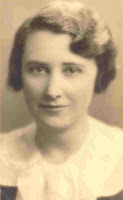Bernadine Freeman Bailey, journalist, photographer, lecturer, American short story writer, and notable author of books for children served as the “war-time” president of the Illinois Woman’s Press Association from 1941-1945.
Born in Mattoon, Illinois, on the 12th of November 1901, Bernadine’s parents were Thomas Oscar Freeman, a prominent physician and surgeon and Nellie Voigt, homemaker and active Woman’s Club member of the community. Her father’s great-grandfather, Moses Freeman had come to the United States from England in time to take part in the Revolutionary War. Her mother’s parents, John and Alberta Voigt had emigrated from Germany. Bernadine’s parents were married in 1898 and had two daughters. Her younger sister, Joy, attended Northwestern University at Chicago and was married to Paul R. Wilkinson. Bernadine graduated with a bachelor’s degree from Wellesley College in Massachusetts in 1922 and earned a master’s degree from the University of Chicago in 1924. She also completed a certificate from the Sorbonne, University of Paris. She spent a period in Indianapolis, Indiana after marrying John Hays Bailey, Ph.D. a hospital scientist.
Bernadine joined the Illinois Woman’s Press Association in 1926 (where she remarried an active member until 1982). By the mid-1930s she was back in Chicago, as an Associate Editor working for Laidlaw Brothers, an educational publisher and with the J.B. Lippincott Company. She also was the founder and director of the Arden Literary Service and became the directing staff editor for Childcraft, a highly popular educational series for young children published first by W.F. Quarrie Co. and later by Field Enterprises (eventually bought out by World Book). From the 1930s through the 1970s she published more than 90 nonfiction books primarily for children. One of the earliest and most popular was The Follett Picture-Story Book of Indians (1936).
A world-wide traveler, Bernadine once commented she had “traveled to almost every country in the world, all except Greenland, I believe.” In a 1938 letter penned in Helsinki to a friend during a long trip through Denmark, Sweden and Finland she admitted, “At times I get quite homesick, and at times feel I could stay in some of these places indefinitely but four months away from home and husband is rather a long time.” In that same letter, Bernadine mentions taking over two hundred photographs of Denmark from which she would select and feature in her next children’s book Little Greta of Denmark (1939).
In 1943, midway through her IWPA presidency, with the U.S. fully engaged in WWII, Bernadine wrote two novels for girls, The Youngest WAAC and the Youngest WAAC Overseas following the adventures of a young WAAC through basic training to earning her way to the rank of officer.
During her career she worked with German-born illustrator Kurt Wiese on a unique set of 50 state picture books, one for each in the United States. Her Children of America Stories were easy and fun for young children to read while learning about children from other cultures and countries. Bernadine’s effervescent talent as an illustrator is featured in the slim 48-page out-of-print gem How People Live in the Suburbs published in 1970. These books along with many other vintage copies of her work and collaborations can still be found on Amazon, eBay and Abebooks.com with a search on the Internet.
On many occasions her writing expressed her personal opinion and beliefs and she was not known to shy away from controversy. In 1969, she wrote The Captive Nations: Our First Line of Defense (about what we now refer to as the “15 former republics” of the Soviet Union) and in March 1970 she gave a highly charged newspaper interview on the subject of the breakup of Soviet Union. Those views and words, as recently as 2014, still bait rebuttal.
During her years as IWPA president she often referred to “the troublous times for individuals, for nations…” through her travels she saw the unrest of the world and the need for something “to depend on”…that there was a need for “more inspiration and stimulation than ever before in order to overcome the unsettling effects of a rapidly shifting world.” In IWPA she found “that much needed inspiration and encouragement through stimulating talks and discussions, through an exchange of opinions and problems, through contacts with interesting, vital persons who are engaged in work similar to our own.”
In May of 1968, Bernadine’s first husband died. She remarried on July 28th, 1971 to Scotsman, Dr. Carson Ritchie, a lecturer, author and sculptor. The ceremony took place at Crown Court Church, Covent Garden in London, England. The couple resided in London.
Bernadine died on October 21st, 1995 – just three weeks shy of her 94th birthday. She is buried in her hometown of Mattoon, Illinois.






A beautiful story, and well-told by Marianne. Marianne’s ability and dedication to bringing the lives and professional achievements of these trailblazing women to the forefront is an important way to share their legacies with IWPA and NFPW members – and to all women and men in the communications industry. They play an important and everlasting part of our history.